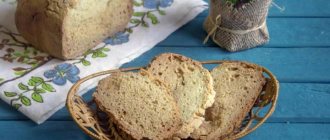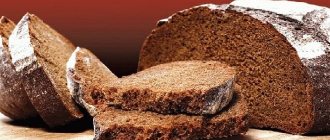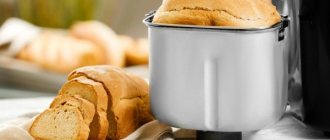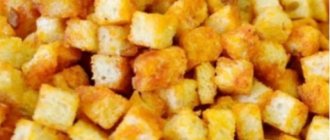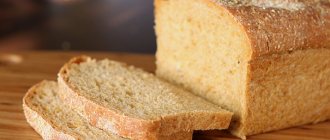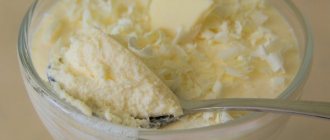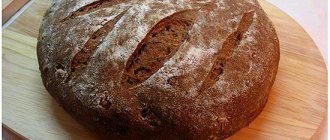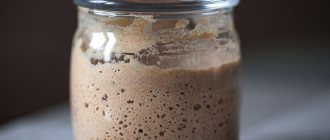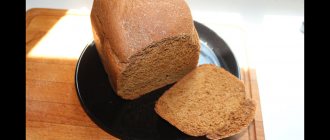For baking white bread, it is best to use wheat sourdough. Today I will share with you a recipe for making it at home. To do this, I’ll first clarify what we need.
We will make wheat sourdough based on rye (a step-by-step recipe for its preparation is described here). This is the easiest way to do it. At the same time, our rye sourdough must be at least 5 months old (subject to regular use or feeding). If the rye base is young and weak, then the white sourdough may not turn out right away, or the bread made from it will be of poor quality (dense and raw instead of fluffy and soft).
I also do not recommend making a wheat sourdough similar to the rye recipe. It almost never works out successfully this way. White flour contains very few nutrients for the active development of beneficial lactic acid bacteria. They are the ones that ferment the mixture of flour and water and form the basis of the sourdough. Therefore, we will use another option that guarantees us a suitable result.
In order for wheat sourdough to be of good quality, you need suitable flour. I would like to note the fact that refined milk is not suitable for this purpose. We will need finely ground wheat flour and some whole grain flour. Such options can be found in organic food and health food stores.
Fine flour, unlike refined flour, is not processed. It is simply ground very finely, so the color is not brightly bleached, but slightly grayish.
All flour must be fresh, as bugs may appear in unprocessed, stale products. They are happy to consume a natural product. In addition, you should not buy cheap options, since there is a high probability of purchasing regular refined flour instead of good quality flour made from environmentally friendly grains.
You can also make wheat bread with rye sourdough, as we did in this recipe. But the taste and external properties of such baked goods will differ from white sourdough bread. Wheat baked goods are usually very fluffy, bright, with a delicate crumb. White sourdough is better suited for baking and sweet products.
Of course, one could argue that all this is not very useful. Rye bread contains much more nutrients. But, if you really want white baked goods, then it is better to cook it at home than to risk your health by eating store-bought buns (based on thermophilic yeast and other harmful chemicals). So let’s take everything into our own hands and prepare a white wheat sourdough starter for bread that is safe for the body.
Ingredients for the initial stage of starting the starter:
— rye sourdough 80 g; — finely ground wheat flour 200 g; - whole grain wheat flour (mine is from spelled) 50 g; — drinking water 285 ml.
Ingredients for feeding the starter for 5 days:
Dear readers, we have opened a channel on YouTube. On it we will post vegetarian recipes, lectures on proper nutrition, cleansing the body, health and a healthy lifestyle. Be sure to subscribe! 
— finely ground wheat flour 180 g (10 servings of 18 g each); — whole grain wheat flour 20 (10 servings of 2 g each); — drinking water 200 ml (10 servings of 20 ml).
White wheat sourdough for bread - homemade recipe
- Take the rye sourdough out of the refrigerator. Let it warm up for 1-2 hours. We feed with rye flour and water. Leave for another 1-2 hours. This process is presented in detail in this article.
- In a deep bowl we place the ingredients for the initial stage of starting the starter. The water should be at room temperature. Mix everything thoroughly. Leave this mixture in a bowl, cover with a towel (for 10-12 hours). It is important that the room temperature is 22-26 degrees Celsius, not too hot, but not too cold.
- After the specified time, take 105 g of the mixture from the bowl and transfer it either to another bowl or to a 1-liter glass jar.
Most of the part that remains in the bowl is the dough. It can be used to make bread. The indicated amount is just right for this recipe. You can start it from the 4th point.
- Add 18 g of fine wheat flour, 2 g of whole grain flour and 20 ml of water to a smaller part of the mixture. Mix everything. Cover with a towel and leave for another 10-12 hours. And we do this 10 times, that is, we feed the starter for five days in the morning and evening. After the last feeding, transfer it to a clean jar, close it with a nylon lid and put it in the refrigerator. You can separate a large part, and just like in the previous point, use it as a dough for bread, and put only a small part in the refrigerator.
If your mixture is too thin or too thick, you can adjust the amount of water you add. Everyone's flour is different, so your timing may vary. The thickness of the starter should resemble rich sour cream.
On the fifth day, the starter will become very voluminous and porous. If you see that it looks like this, it has a pleasant sour aroma, then it is ready. If you have any doubts, you can continue feeding for another two days.
This is how you can make white wheat sourdough for bread from rye sourdough.
©
Subscribe to our Telegram channel and always be aware of new articles:
« Previous entry
Who is Raymond Calvel
After World War II, American soldiers returning from France were delighted with the bread they enjoyed there. However, after this time, the quality of French bread began to decline. And by the 60s, French bread had become tasteless, bland and unimpressive.
Professor Raymond Calvel had a huge influence on the revival of French baking. Professor Calvel shared the techniques that have brought French bakers back to the top level.
The best book for bakers
One of the best baking books on baking is Raymond Calvel's The Taste of Bread. She inspires bakers and offers techniques that will help them reach the top of the art of bread baking. The only drawback of this book is its price. You can also download “The Taste of Bread” by Raymond Calvel in electronic form, but you have to try hard, as such attempts are quickly suppressed by copyright holders.
Raymond Calvel is a famous French baker who has devoted 70 years to baking bread.
In the same book, R. Calvel also offers a recipe for his popular sourdough. It is suitable for those who have just begun to get acquainted with sourdough bread and those who have been baking for a long time.
Definition
Traditionally, sourdough means an acidic substance (for example, a particle of old dough) that is put in to ferment something. [1a]
According to GOST, sourdough is a semi-finished bakery product obtained by fermenting a nutrient mixture with lactic acid and propionic acid bacteria and baker’s yeast . In other words, in baking, sourdough itself is any fermenting bread dough containing active specific microflora, regardless of whether it is made from wheat or rye flour and what consistency it has [2]. Part of this starter is used when kneading dough for future bread, and the remaining small portion is used to prepare a new portion of starter with the addition of water and flour[3].
In foreign literature, the word sourdough is written as: sourdough (English), levain (French), Augshten (German)
Results
In fact, this article provides basic points that allow you to navigate the beginning of the many-sided path of baking. Over time, you will create your own way of life, you will have confidence and a feeling on the basis of which you can begin your own experiments.
There is always an unpredictable scenario for the development of events in the behavior of sourdough and changes in the quality of bread, the reason for which may be hidden in a variety of external or internal factors.
Commercial sourdough or borrowed from friends will gradually become local - it will be filled with micro-residents from the surrounding space of the house [10] and flour. Warm conditions will favor some microorganisms, while others, the most hardened ones, will continue to slowly carry out their painstaking work in cold conditions.
Bread baked by different hands in neighboring houses will always be different, albeit subtly, like the leaves of the same tree. The baker's manual labor, multiplied by the invisible work of billions of domestic microorganisms, the leaven will always bear the invisible imprint of exclusivity with the special aroma and unique taste of its native bread.
Preparation for hatching
As Raymond Calwell noted in his book The Taste of Bread, many people try to create a starter culture with various ingredients such as yogurt, grapes, to speed up the process. But by the time you get to the point of fermenting the bread, there will be no trace left of this starting ingredient.
You can find several sourdough recipes that use a range of fruits to develop the starter, but Professor Calvel is convinced that it is better not to use anything else other than flour and water to prepare your sourdough.
To introduce Calwell sourdough, you will need to prepare the following ingredients:
- rye flour;
- 1st grade wheat flour or whole grain;
- white malt extract or honey;
- salt;
- water.
At first, the sourdough according to Professor Calvel’s recipe will be quite dense. And mixing all the components involves vigorous kneading of the sourdough dough. You can knead with your hands, but then the process will take at least 20 minutes, or you can use a dough mixer.
Don't throw it away! What to do with extra starter?
What does extra mean, you ask? This is the same starter that you discard before feeding. Shouldn't this good get in the way? So, there are many options here!
There are all kinds of sourdough recipes. Some people make pancakes, pizza dough, muffins, etc! We make delicious crackers with rosemary and basil from our garden. Over time I will continue to add recipes to the sourdough section of this blog. Thank you for your patience!
SEE ALSO:
HOW TO MAKE FLAVORED AND CRISPY CRACKERS?
SOURDOUND PIZZA: STEP-BY-STEP RECIPE!
Tips for caring for Calwell sourdough
The starter shows its best qualities immediately after it is hatched. In the first months it will retain all its aromatics. Over time, the starter loses its aroma, and I recommend breeding a new one.
In addition, sourdough does not withstand cold testing well. If you store it in the refrigerator, it will undoubtedly survive, but its bouquet of aromas will quickly become poorer.
If you have any questions, write in the comments. I wish you good luck in developing wheat sourdough according to the recipe of Professor Raymond Kalevel.
There are also other recipes for wheat sourdough on my website. I want to share with you one of my favorite methods - this is P. Reinhart's pineapple juice starter - First day of hatching. Try to bring it out, I am sure that you will definitely succeed!
How long does it take to prepare active starter?
The time it takes for your starter to become ready to bake will depend on how active your starter is, how cold or warm your home is, and the type of flour you feed. For example, rye flour increases activity very quickly.
Goal: When adding starter to your recipe, it should be at peak activity. You can tell it has reached its maximum when it is very expanded and bubbly, no longer rising, but not falling yet.
Important Note:
Never add all of your starter to a recipe! If you want to preserve your starter, always leave half behind each time you bake. Then continue to feed it and use it indefinitely in the future! You just did all the hard work to create this baby. Take care of her! We'll cover this again in the baking recipes post, but I wanted to mention it here too.
